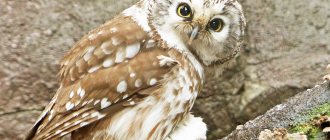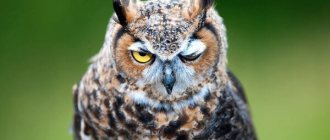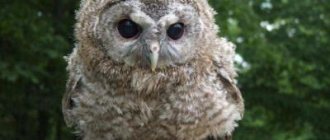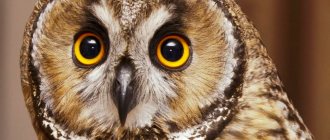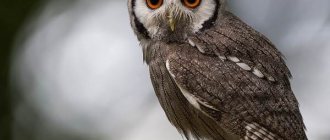From time immemorial, owls have been credited with a special role in the relationship between wildlife and the other world. The nocturnal lifestyle of these feathered predators, the peculiarities of their behavior and appearance in the everyday mind are often associated with mystical forces and strange phenomena.
There is an opinion that an eagle owl appears near human habitation as a harbinger of misfortune, while an owl, on the contrary, protects the owners of the house from all sorts of troubles.
It is unlikely that such a mythologized idea of the species differences between owls and eagle owls can be considered convincing. They are not similar in other, purely morphological characteristics, type of behavior and method of hunting.
Dimensions
Body size is one of the first characteristics by which you can understand the difference between an eagle owl and an owl. Representatives of the former are almost always larger than the latter.
Most species of eagle owls are distinguished by significant body dimensions, which, as a rule, are characterized by a barrel-shaped shape. The largest fish owl with a majestic wingspan and a massive body belongs to this genus of owls.
Scarecrows are slightly inferior to him in size. Their body length is usually between 65-75 cm, although larger representatives are occasionally found.
Most owls are significantly smaller in size than eagle owls. The only exceptions are the polar owl and the great gray owl. The white owl even initially belonged to the genus of eagle owls precisely because of its impressive dimensions, but was later isolated as a separate species.
The great gray owl even exceeds the largest eagle owl in body weight, and is comparable in length to scarecrows. But the absence of feathered ears identifies it as an owl, and the characteristic concentric circles around the eyes and the spot under the beak make it possible to recognize it as a representative of the tawny owl family.
Owls from the genus of owls
Owls are relatively small owls with a larger build. They have no feathered ears. The bird has a clearly defined facial disc of black color with a white frame.
The short tail gives a visual misleading impression of the wings - they appear longer than they actually are. The legs are feathered differently in different forms of owls: in the southern ones, their toes are covered with bristles, in the northern ones, feathering is present right up to the claws.
Under the beak they have a black spot, reminiscent of a beard, framed by white, horizontally elongated spots. The ridges between the eyes are light gray, eyebrow-shaped (crescent-shaped), located from the beak towards the inside of the facial disc. The pupils are black, the iris is yellow. The eyes are small, the beak is yellow.
Among them, occasionally (eastern populations) there are completely black birds, in which bright yellow eyes are clearly visible on the facial disc.
Females here are larger than males and are indistinguishable in color.
The owl differs from the eagle owl in its brighter and more saturated gray color, a bright, clearly defined facial disc with many cone circles, the absence of “ears,” medium-sized yellow eyes, and a darker color.
Feather ears
If you see an owl of medium size, doubt may creep in: is it not an eagle owl? The difference in this case is determined by the presence of characteristic feather “ears”. Large tufts of feathers above the eyes, giving the bird a particularly stern appearance, are characteristic of all species of eagle owls.
But there is one small caveat: such signs also occur in some owls. In particular, feathery “ears” are characteristic of the long-eared owl and a number of cutworms. It’s quite easy to draw the line between where the owl is and where the eagle owl is, if you remember the difference in size.
All long-eared owls are smaller in size than eagle owls. Owls, on the other hand, are among the smallest species of owls, for which they are often called “miniature eagle owls.” Therefore, it will not be difficult to draw mutually exclusive parallels of characteristics in order to understand the difference between these owls and eagle owls.
Beautiful bird eagle owl. How does an eagle owl differ from an owl in appearance?
The eagle owl is an unusually attractive bird. This is a larger owl, with a wingspan of which their length reaches from 150 to 170 centimeters, and the length of each wing is up to 50 centimeters. Its weight is about 2 kg.
Adult birds have a rusty yellow color, densely mottled with brownish blackish shades.
Its eyes are reddish-yellow, its beak is dark, one might say black. On the sides of his head there are tufts of feathers that form something like ears (nothing in common with real ears). Both females and males have the same coloration.
Plumage color
Most eagle owls are distinguished by a more variegated and spotted plumage color compared to owls. The latter are characterized by a uniform color of feathers.
Many eagle owls live in forest thickets, so more variegated colors give them the most camouflage appearance. Also, the difference between them and owls is the presence of clearly visible dark stripes on the head and upper back. In addition, eagle owls' paws are usually densely furred.
Facial disc
This is another important characteristic that allows you to understand the difference between an eagle owl and an owl. The facial disc is characteristic of most representatives of owls and barn owls.
It is most pronounced in barn owls - the most famous owls with a white face that has a heart-like appearance. In many other species of owls, the facial disc is more or less noticeable, while for eagle owls it is not characteristic at all.
Nutrition
The diet of a bird of prey includes rodents, birds, hares, reptiles, and large insects. Even hedgehogs and squirrels are caught in the eagle owl's claws!
- Winter birds | Wintering birds
Owl - habitat, characteristics of species, family, diet, life expectancy (110 photos + video)
Pigeon - types and differences, features, flight, nutrition and reproduction + 88 photos
The formidable hunter is not averse to eating fish. In nature, there is even a fish eagle owl that is larger than the common one.
Typically, the eagle owl settles in places where it can obtain food in abundance. So he is almost never hungry. In addition, he can hide the leftover meat in a kind of hiding place and continue his meal at another time.It is not surprising that the eagle owl manages to make such reserves, because his prey can be ten times larger than the hunter himself! He is not averse to attacking even a roe deer.
Lifestyle
The significant difference between an owl and an eagle owl lies in the lifestyle of these birds. All owls are considered nocturnal predators. They usually hunt at night and rest during the day. The exception is the polar owl, which is due to the peculiarity of its habitat and the peculiar uniqueness of the species, which in general is significantly different from a number of its relatives.
Eagle owls also hunt at night. But the peculiarity of the vision of these birds allows them to hunt in search of prey even during daylight hours. Since they are the leaders in size in the owl family, their prey usually exceeds what most owls catch.
Eagle owls also destroy various rodents, but their prey can be not only rats, but also hares, and even larger animals - roe deer, goats, badgers. Eagle owls are also one of the few birds that can even hunt hedgehogs and consume these prickly animals as food. They do not disdain to hunt their owl relatives, who are distinguished by their smaller dimensions.
Owl and man
The eagle owl bird has no natural enemies. No predatory animal is at risk of attacking an adult bird. Only young chicks left by their parents while searching for food are at risk.
The greatest danger to eagle owls is people. Human economic activity leads to the death of entire families of owls.
The main reason for the mortality of these birds is poisoning with strong chemicals that are used in growing and processing various crops.
The chemicals end up on rodents, and when they eat them, the eagle owl receives a shock dose of toxic substances. The poisoned bird becomes lethargic and quickly dies.
Today, feathered predators are threatened with complete extinction, therefore the eagle owl subspecies is especially protected; the Red Book contains its detailed description. Scientists constantly monitor the population of owl families.
Habitats
Owls usually live in forests and open areas. Although eagle owls are considered typical forest birds, they are still less picky in terms of housing. They can settle in very different areas (in the mountains, in the desert), and build their nests not only in tree hollows, but also among rocks, on the ground.
Although these large birds are not afraid of people, they still prefer not to nest near cities. Some species of owls are not afraid to roost in the attics of residential buildings. Moreover, these birds are more widespread around the world than eagle owls, most of whose populations are concentrated in Eurasia and North America.
How do they reproduce?
The main mating season for owls is in the spring, but with an abundance of food and favorable weather conditions, they can re-lay eggs and hatch chicks. Owls are characterized by the formation of monogamous pairs, with the male remaining with the female even after the end of the breeding season, taking part in raising the offspring.
Owls do not build nests, but prefer to arrange shelter in hollows, openings between stones, and crevices. Birds that live near human settlements nest under roofs and in attics.
The female lays from 3-4 to 10 eggs. The incubation period lasts about a month, during which time the male actively hunts, providing food for his mate. The chicks that are born are covered with down, their eyes and ear openings are closed. By 2 months, the owlets begin to fly. By this time, the down is replaced by feathers.
Great Gray Owl
Since the chicks hatch one after another, by the time the last chick appears, the first ones have already grown noticeably and eat almost all the prey brought by their parents. Often the last to hatch chicks die of starvation, unable to compete with their larger older brothers and sisters.
CUCKOO
Flight Features
The difference between an eagle owl and an owl is also clearly visible in its flight characteristics. Eagle owls have sharp feather tips, while owls have rounded feathers. Due to this feature of the flight wings and their characteristic bend, representatives of the first species fly, emitting a characteristic whistle during rapid flight.
Owls glide almost silently also due to the presence of soft pubescence on their wings. This feature allows them to fly up to the target chosen as prey absolutely unnoticed.
Mating season
Almost all representatives of owls are monogamous. There is no particular difference between eagle owls and owls in this regard. But there are some differences in the mating “flirts” of these birds. Male owls usually make inviting calls (often hoots) to attract females.
Eagle owls organize “negotiations”: males and females alternately call out to each other. Among owls, such behavior during the mating season is characteristic only of long-eared owls. The mating “trills” of eagle owls are rougher compared to the sounds characteristic of owls. For example, scops owls can produce real melodic trills.
Female eagle owls incubate eggs a little longer than owls (30-35 days versus 20-30). The number of future offspring they have is usually also smaller. Some species of eagle owls lay no more than 1-2 eggs. They are unpretentious in choosing a place to breed their offspring, and can lay eggs in a hole right on the ground, without equipping it in any way.
Unlike most owls, which hunt only at night, the eagle owl is capable of obtaining food during the day: it has keen eyesight and can rise quite high in flight to find suitable prey. Most often these are wood grouse, partridges, pheasants, field mice - inhabitants of sparse forest thickets and open areas in the forest-steppe and steppe zones. In such places it is easier for the eagle owl to hunt due to its wingspan.
Of all the owls, the long-eared owl bears the greatest resemblance to the eagle owl. This species has the same type of head plumage, wing shape, tail and body. However, even with such similarity, the long-eared owl is not a smaller copy of the eagle owl. It has dull colored feathers and a bright orange iris, while the eagle owl's eyes appear red in the dark and their feathers shine in daylight.
The lack of feathered ears is not the only feature that distinguishes other owls from the eagle owl. A characteristic feature of many of them is a hard corolla of short feathers framing the front part of the head; the eagle owl does not have it.
The feathers on the wings of ordinary owls have rounded ends and are softly jagged on the outside. This makes their flight silent and allows the birds to literally glide near the surface of the earth. The flapping of an eagle owl's wings in flight produces a clearly audible whistling sound, since its flight feathers are stiffer and do not have fringed edges.
